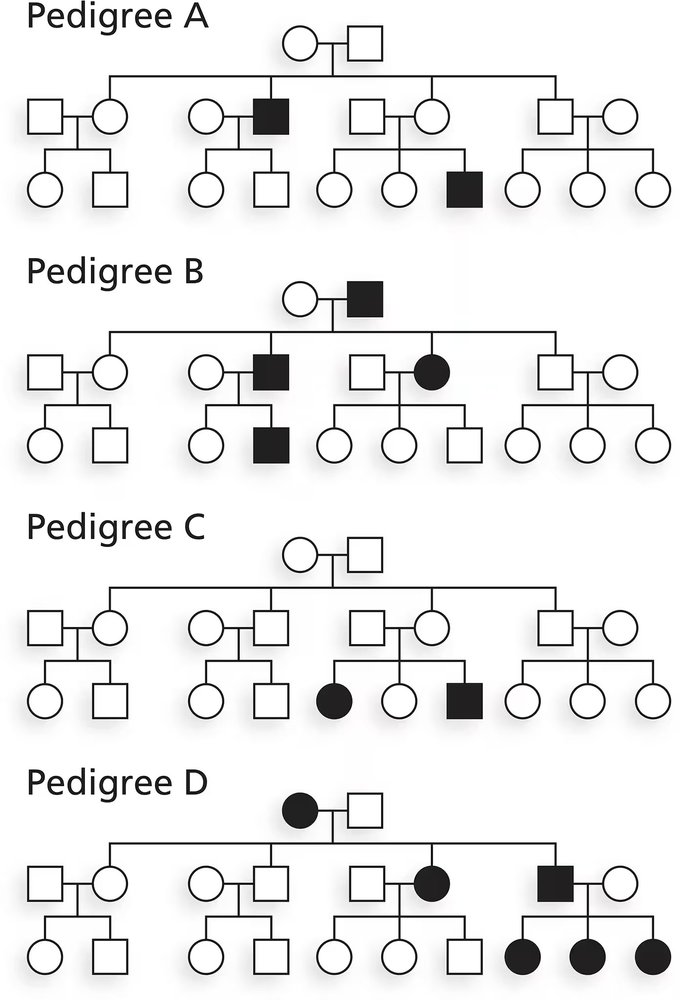If you knew that a devastating late-onset inherited disease runs in your family (in other words, a disease that does not appear until later in life) and you could be tested for it at the age of 20, would you want to know whether you are a carrier? Would your answer be likely to change when you reach age 40?
Table of contents
- 1. Introduction to Genetics51m
- 2. Mendel's Laws of Inheritance3h 37m
- 3. Extensions to Mendelian Inheritance2h 41m
- 4. Genetic Mapping and Linkage2h 28m
- 5. Genetics of Bacteria and Viruses1h 21m
- 6. Chromosomal Variation1h 48m
- 7. DNA and Chromosome Structure56m
- 8. DNA Replication1h 10m
- 9. Mitosis and Meiosis1h 34m
- 10. Transcription1h 0m
- 11. Translation58m
- 12. Gene Regulation in Prokaryotes1h 19m
- 13. Gene Regulation in Eukaryotes44m
- 14. Genetic Control of Development44m
- 15. Genomes and Genomics1h 50m
- 16. Transposable Elements47m
- 17. Mutation, Repair, and Recombination1h 6m
- 18. Molecular Genetic Tools19m
- 19. Cancer Genetics29m
- 20. Quantitative Genetics1h 26m
- 21. Population Genetics50m
- 22. Evolutionary Genetics29m
2. Mendel's Laws of Inheritance
Sex-Linked Genes
Problem 20a
Textbook Question
For each pedigree shown,

Identify which simple pattern of hereditary transmission (autosomal dominant, autosomal recessive, X-linked dominant, or X-linked recessive) is most likely to have occurred. Give genotypes for individuals involved in transmitting the trait.
 Verified step by step guidance
Verified step by step guidance1
Examine the pedigree chart carefully to determine the inheritance pattern. Look for key indicators such as whether the trait appears in every generation (suggesting dominance) or skips generations (suggesting recessiveness). Also, check if the trait is more common in one sex (suggesting X-linked inheritance).
Determine if the trait is autosomal or X-linked. If males and females are equally affected, it is likely autosomal. If the trait is more common in one sex (e.g., males in X-linked recessive), it may be X-linked.
Assess whether the trait is dominant or recessive. If affected individuals have at least one affected parent, the trait is likely dominant. If unaffected parents can have affected offspring, the trait is likely recessive.
Assign genotypes to individuals based on the inheritance pattern. For autosomal dominant traits, affected individuals will have at least one dominant allele (e.g., 'AA' or 'Aa'). For autosomal recessive traits, affected individuals will have two recessive alleles (e.g., 'aa'). For X-linked traits, consider the sex chromosomes: males (XY) will have one X-linked allele, while females (XX) will have two.
Validate your hypothesis by checking if the assigned genotypes are consistent with the inheritance pattern across the entire pedigree. Adjust the genotypes if necessary to ensure they align with the observed transmission of the trait.
 Verified video answer for a similar problem:
Verified video answer for a similar problem:This video solution was recommended by our tutors as helpful for the problem above
Video duration:
44sPlay a video:
Was this helpful?
Key Concepts
Here are the essential concepts you must grasp in order to answer the question correctly.
Pedigree Analysis
Pedigree analysis is a diagrammatic method used to trace the inheritance of traits through generations in a family. It helps identify patterns of inheritance by mapping out relationships and phenotypes of individuals. Understanding how to read and interpret pedigrees is crucial for determining whether a trait is autosomal or X-linked, as well as dominant or recessive.
Recommended video:
Guided course

Pedigree Flowchart
Patterns of Inheritance
Patterns of inheritance refer to the predictable ways traits are passed from parents to offspring. The main patterns include autosomal dominant, where only one copy of the allele is needed for the trait to manifest, and autosomal recessive, where two copies are required. X-linked inheritance involves genes on the X chromosome, with X-linked dominant traits appearing in both sexes, while X-linked recessive traits are more common in males.
Recommended video:
Guided course

Organelle Inheritance
Genotype and Phenotype
Genotype refers to the genetic constitution of an individual, specifically the alleles they carry for a particular gene, while phenotype is the observable expression of those genes. Understanding the relationship between genotype and phenotype is essential for predicting how traits will be expressed in offspring and for determining the genotypes of individuals in a pedigree based on their phenotypic traits.
Recommended video:
Guided course

Gamete Genotypes
Related Videos
Related Practice
Textbook Question
669
views


